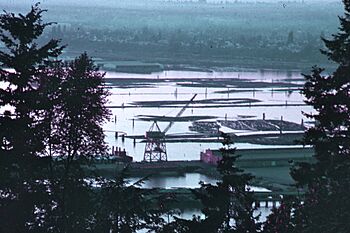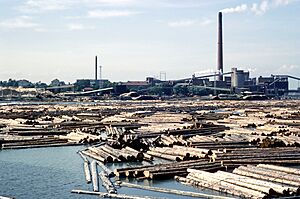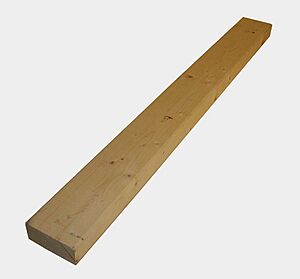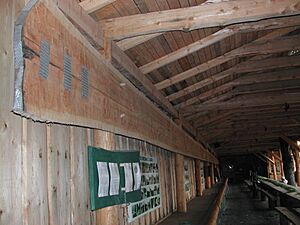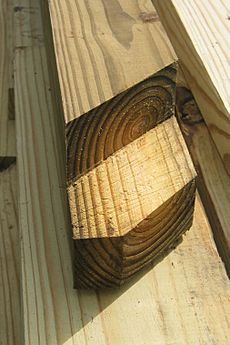Lumber facts for kids
Lumber is wood that has been cut and shaped into useful sizes, like beams and boards. It's mostly used for building homes, for things like walls, floors, and window frames. But lumber is also used for many other things! In some places, like the United Kingdom, Australia, and New Zealand, people call this processed wood "timber." In the United States and Canada, "timber" usually means uncut wood, like logs or standing trees.
Lumber can be sold as rough lumber, which is just cut from the log, or finished lumber, which has been smoothed on one or more sides. Rough lumber is the raw material for making furniture and other items that need cutting and shaping. It comes from many types of trees, including both hardwoods (like oak) and softwoods (like pine), often because softwoods are cheaper.
Finished lumber comes in standard sizes, mainly for building. Most of it is softwood from conifer trees like pine, fir, spruce, cedar, and hemlock. About 80% of all lumber comes from softwoods. Some hardwoods are also used for special things like high-quality flooring.
Contents
- What Do We Call It?
- History of Lumber
- How Logs Become Lumber
- Standard-Sized Lumber
- Problems with Lumber
- How Long Does Lumber Last?
- Timber Framing
- Lumber and the Environment
- Benefits of Lumber for the Environment
- What Happens to Lumber at the End of its Life?
- Lumber in the Circular Economy
- Secondary Raw Material
- See also
What Do We Call It?
In the United States and Canada, cut and shaped wood is called lumber. The word timber is used for standing trees or logs that haven't been cut into boards yet.
However, in Britain and some other countries, timber can mean both standing trees and processed wood. In the UK, the word lumber is rarely used for wood and has other meanings.
Re-manufactured Lumber
Re-manufactured lumber is wood that has been processed a second or third time. This usually means lumber cut for industrial uses or for making wood packaging. It's often cut into sizes that big sawmills don't usually produce.
For example, re-sawing means splitting a thick piece of wood into two or more thinner pieces. Imagine taking a 2x4 (which is about 1.5 by 3.5 inches) and cutting it lengthwise into two 1x4s (about 0.75 by 3.5 inches). That's re-sawing!
Plastic Lumber
You can also find lumber made from recycled plastic or new plastic. The wood industry hasn't been too happy about this new type of lumber. Adding fiberglass to plastic lumber makes it stronger, lasts longer, and resists fire better. Some plastic lumber can even burn slower than most treated wood.
Timber Mark
A timber mark is a special code stamped onto cut wood. It's made with a hammer and shows who has the license to cut that wood.
History of Lumber
The word lumber as we know it today, meaning sawn planks of wood, started being used in North America in the 1600s.
In 1420, the Madeira islands were settled by the Portuguese. The settlers cleared huge forests to grow crops. The trees they cut down were processed at sawmills and sent to the mainland.
In 1593, a Dutch windmill owner named Cornelis Corneliszoon van Uitgeest invented the first sawmill powered by wind. This invention made cutting logs into planks 30 times faster than the old hand-powered sawmills!
How Logs Become Lumber
Logs are turned into lumber by being sawn, chopped, or split. Sawing with a rip saw is the most common way. This method allows sawmills to use logs that might not be perfect, even those with irregular grain or large knots, making it more cost-effective.
Here are some ways logs are sawn:
- Plain sawn: The log is cut straight through without changing its position. The wood grain usually runs across the width of the boards.
- Quarter sawn and rift sawn: These methods cut the wood so that the tree's growth rings are mostly straight up and down (perpendicular) to the sides of the board. This can make the wood more stable.
- Boxed heart: The very center of the log (called the pith) stays inside the timber, post, or beam.
- Free of heart center (FOHC): This means the timber, post, or beam is cut from the side of the log, so it doesn't include the pith.
- Free of knots (FOK): This means the wood has no knots in it.
Standard-Sized Lumber
Standard-sized lumber, also called dimensional lumber, is cut to specific widths and depths. Carpenters use it a lot for building wooden structures. Common sizes include "2x4" (two-by-four), "2x6", and "4x4". The length of the board is usually chosen separately. So, you can find 2x4s that are 4, 8, or 12 feet long. In Canada and the United States, standard lengths for lumber are 6, 8, 10, 12, 14, 16, 18, 20, 22, and 24 feet. For building walls, you can even buy "precut studs" that are already the right length for common ceiling heights like 8, 9, or 10 feet.
North American Softwoods
The longest piece of dimensional lumber you can get is limited by the size of the tree it comes from, usually around 24 feet. However, there are special "engineered wood products" that are made by gluing together smaller pieces, strands, or fibers of wood. These can be much longer and stronger than regular wood.
Pre-cut studs save builders a lot of time because they are already cut to the perfect length for standard ceiling heights. This means builders don't have to measure and cut each one.
In North and South America, "two-bys" (like 2x4s, 2x6s, etc.) and 4x4s are very common in modern construction. They are the basic parts for building houses. Softwood dimensional lumber is typically used for construction, while hardwood boards are more often used for making cabinets or furniture.
It's important to know that the nominal (named) size of lumber is usually bigger than its actual size. For example, a "2x4" board isn't actually 2 inches by 4 inches. After drying and planing (smoothing), it ends up being about 1.5 inches by 3.5 inches. This is because, in the past, the nominal size was the size of the wet, rough board before it dried and was smoothed. Today, the standards specify the final finished size.
| Nominal (named) size (inches) |
Actual size (inches) |
Actual size (mm) |
Nominal (named) size (inches) |
Actual size (inches) |
Actual size (mm) |
Nominal (named) size (inches) |
Actual size (inches) |
Actual size (mm) |
Nominal (named) size (inches) |
Actual size (inches) |
Actual size (mm) |
Nominal (named) size (inches) |
Actual size (inches) |
mm |
|---|---|---|---|---|---|---|---|---|---|---|---|---|---|---|
| 1 × 2 | 3⁄4 × 1+1⁄2 | 19 × 38 | 2 × 2 | 1+1⁄2 × 1+1⁄2 | 38 × 38 | |||||||||
| 1 × 3 | 3⁄4 × 2+1⁄2 | 19 × 64 | 2 × 3 | 1+1⁄2 × 2+1⁄2 | 38 × 64 | |||||||||
| 1 × 4 | 3⁄4 × 3+1⁄2 | 19 × 89 | 2 × 4 | 1+1⁄2 × 3+1⁄2 | 38 × 89 | 4 × 4 | 3+1⁄2 × 3+1⁄2 | 89 × 89 | ||||||
| 1 × 5 | 3⁄4 × 4+1⁄2 | 19 × 114 | ||||||||||||
| 1 × 6 | 3⁄4 × 5+1⁄2 | 19 × 140 | 2 × 6 | 1+1⁄2 × 5+1⁄2 | 38 × 140 | 4 × 6 | 3+1⁄2 × 5+1⁄2 | 89 × 140 | 6 × 6 | 5+1⁄2 × 5+1⁄2 | 140 × 140 | |||
| 1 × 8 | 3⁄4 × 7+1⁄4 | 19 × 184 | 2 × 8 | 1+1⁄2 × 7+1⁄4 | 38 × 184 | 4 × 8 | 3+1⁄2 × 7+1⁄4 | 89 × 184 | 8 × 8 | 7+1⁄2 × 7+1⁄2 | 191 × 191 | |||
| 1 × 10 | 3⁄4 × 9+1⁄4 | 19 × 235 | 2 × 10 | 1+1⁄2 × 9+1⁄4 | 38 × 235 | |||||||||
| 1 × 12 | 3⁄4 × 11+1⁄4 | 19 × 286 | 2 × 12 | 1+1⁄2 × 11+1⁄4 | 38 × 286 | |||||||||
The actual sizes of finished lumber have changed over time. For example, in 1910, a "1-inch" board was about 13/16 inches thick. By 1961, it was set to 3/4 inch. A "2-inch" board was reduced from 1 5/8 inches to the current 1 1/2 inches. This means that today's lumber is a bit smaller than it used to be, even for the same "nominal" size.
Lumber Grades and Standards
Not all pieces of lumber are the same. They can have different qualities, like knots or cracks, which affect their strength and how they look. Because of this, lumber is given different "grades."
In the United States, national standards for lumber started in 1924. These standards set rules for lumber sizes, grades, and how much moisture it should have. These rules help make sure that lumber is consistent and fair for both manufacturers and buyers. The American Lumber Standard Committee sets the current standards.
Canada also has its own grading rules to ensure lumber quality. These grades consider things like moisture content and size. The National Lumber Grades Authority (NLGA) writes and maintains Canada's lumber grading rules.
Over the years, the quality of lumber has changed because forests have changed. We used to get wood from slow-growing old forests, but now much of it comes from fast-growing tree farms. This has sometimes led to concerns about lumber quality.
For special uses where high strength is very important, like for roof trusses or large beams, there's "machine stress-rated" lumber. Machines test each piece to measure its stiffness and strength, giving a more exact idea of how strong it is. This helps builders use the right wood for the job without overbuilding.
In Europe, lumber is also graded for strength. Common grades for softwoods are C16, C18, C24, and C30, with higher numbers meaning more strength. For hardwoods, there are D-classes like D24, D30, and so on. These numbers refer to the wood's bending strength.
North American Hardwoods
How hardwood lumber is sold in North America is different from softwoods. Hardwood boards are often sold rough-cut, or just planed (smoothed) on their two wider sides. They might come in random widths but a specific thickness, and sometimes in random lengths. However, you can also find standard-sized hardwood boards in stores, often in a few common lengths. Hardwoods are usually sold by the "board-foot," which is a measure of volume (144 cubic inches).
| Nominal (named) rough-sawn size | S1S (smoothed on one side) | S2S (smoothed on two sides) |
|---|---|---|
| 1⁄2 in | 3⁄8 in (9.5 mm) | 5⁄16 in (7.9 mm) |
| 5⁄8 in | 1⁄2 in (13 mm) | 7⁄16 in (11 mm) |
| 3⁄4 in | 5⁄8 in (16 mm) | 9⁄16 in (14 mm) |
| 1 in or 4⁄4 in | 7⁄8 in (22 mm) | 13⁄16 in (21 mm) |
| 1+1⁄4 in or 5⁄4 in | 1+1⁄8 in (29 mm) | 1+1⁄16 in (27 mm) |
| 1+1⁄2 in or 6⁄4 in | 1+3⁄8 in (35 mm) | 1+5⁄16 in (33 mm) |
| 2 in or 8⁄4 in | 1+13⁄16 in (46 mm) | 1+3⁄4 in (44 mm) |
| 3 in or 12⁄4 in | 2+13⁄16 in (71 mm) | 2+3⁄4 in (70 mm) |
| 4 in or 16⁄4 in | 3+13⁄16 in (97 mm) | [convert: invalid number] |
Hardwood lumber is often talked about using a "quarter system" for thickness. For example, "4/4" (four quarter) means a 1-inch thick board, and "8/4" (eight quarter) means a 2-inch thick board. This system is mostly for rough-sawn hardwood, not the smoothed, standard-sized lumber.
For furniture making, hardwoods are usually cut in the fall and winter. This is when the tree's sap isn't flowing much. If hardwoods are cut in spring or summer, the sap can stain the wood and lower its value for furniture.
Engineered Lumber
Engineered lumber is wood that has been specially made by a factory for specific building purposes. It's designed to be very strong and reliable. Here are some main types:
- Laminated Veneer Lumber (LVL): This is made from many thin layers of wood glued together. LVL comes in specific thicknesses and depths. It's used for strong beams that support heavy loads over long distances, like above garage doors or where a wall has been removed. You can't cut holes or notches in LVL, but you can nail into it.
- Wooden I-joists: These look like the letter "I" and are used for floor joists (the beams that support floors). They are made with a top and bottom part of solid wood, and a middle part (webbing) made from oriented strand board (OSB). I-joists are designed for long spans. They often have pre-cut "knockouts" for small holes, but larger holes need approval from an engineer.
- Finger-jointed lumber: Regular solid lumber usually comes in lengths up to 24 feet. But you can make much longer pieces (up to 36 feet) by joining small pieces of wood together using "finger joints" and glue. This is also common for pre-cut wall studs. It's a good, affordable choice for wood that will be painted, as the joints might show through stain.
- Glulam beams: These are made by gluing together several pieces of 2x4 or 2x6 lumber to create a much larger beam, like a 4x12 or 6x16. This allows builders to create big, strong beams without needing to cut down very large, old trees.
- Manufactured trusses: Trusses are pre-made triangular structures used for roofs and ceilings. They are often easier and faster to install than building a roof frame piece by piece. While they might cost more upfront, they can save a lot of labor time during construction.
Different Pieces and Cuts
Lumber comes in many shapes and forms, often named by their use:
- Square and rectangular forms: These include planks, slats, battens, boards, and laths. Larger pieces are called posts, beams, studs (for walls), rafters (for roofs), and joists (for floors).
- Rod forms: These include poles and dowels.
Timber Piles
In the United States, timber piles (long poles driven into the ground to support structures) are usually cut from southern yellow pines and Douglas-fir trees. These piles can be treated with chemicals to protect them from rot and insects, especially if they will be used in wet ground.
Problems with Lumber
Lumber can have different problems, or "defects," which are grouped into four main types:
Problems from Cutting
When logs are cut into lumber, some defects can happen:
- Chip mark: Marks left on the wood surface by chips during cutting.
- Diagonal grain: Happens when the wood is not sawn correctly.
- Torn grain: A small dent on the surface, often from a tool falling.
- Wane: When part of the original rounded surface of the log is left on the finished board.
Problems from Fungi and Animals
Fungi (like mold or mushrooms) can attack wood if three things are present:
- The wood is very wet (more than 25% moisture).
- The temperature is warm enough.
- There is oxygen.
If wood is kept dry (less than 25% moisture), it can last for hundreds of years without rotting. Wood that is completely underwater might not rot either, because there isn't enough oxygen.
Common fungi defects in lumber include:
- Blue stain
- Brown rot
- Dry rot
- Heart rot
- Sap stain
- Wet rot
- White rot
Insects and other creatures can also damage lumber:
- Woodboring beetles
- Marine borers (like tiny sea worms)
- Teredos (shipworms)
- Termites
- Carpenter ants
- Carpenter bees
Problems from Natural Forces
Two main natural forces cause defects: unusual growth and cracks in the wood. Cracks are often called "shakes." A "ring shake" happens when the wood separates along the growth rings, either in the standing tree or when it's cut down. Shakes can make the wood weaker and allow moisture to get in, which can lead to rot.
A "check" is a crack on the surface of the wood. It happens when the outside of the wood dries and shrinks faster than the inside. Checks usually follow the wood grain. A "split" is a crack that goes all the way through the wood. Checks and splits are more common at the ends of boards because they dry faster there.
Also, if wood expands or shrinks unevenly due to changes in moisture, it can warp (bend or twist), making it less useful.
Problems from Drying (Seasoning)
The process of drying lumber is called "seasoning." This can be done in a special oven (kiln-dried) or by air. If wood isn't dried properly, it can lead to splits, bowing (bending), and honeycombing (cracks inside the wood). Seasoning removes the moisture from the wood cells to make it stable.
How Long Does Lumber Last?
If cared for properly, wood can last a very long time. But it can be damaged by fungi and insects. Building codes have rules to protect wood from these threats.
Here are four ways to protect wooden structures and make them last longer:
- Control moisture: Design buildings so water doesn't get in, which prevents rot.
- Control pests: Keep termites and other insects away.
- Use durable materials: Use wood that naturally resists decay or has been treated with preservatives.
- Good quality control: Make sure the building is designed, built, and maintained well.
Controlling Moisture
Wood naturally absorbs and releases water to match the air around it. This is called being "hygroscopic." The amount of water in wood is called its "moisture content." To prevent rot, the moisture content of untreated wood should stay below 19%. Water itself doesn't harm wood, but too much moisture allows fungi to grow and cause decay.
The main goal is to keep water out of the building and balance the moisture inside. Good building design and construction can protect a wooden building from decay. For areas that might get wet often, like outdoor decks or exposed beams, builders use wood that naturally resists rot or has been treated with special chemicals.
Controlling Termites and Other Insects
In areas where termites are a problem, building rules often include these steps:
- Slope the ground away from the building's foundation so water drains away.
- Cover exposed ground in crawl spaces with plastic film and keep enough space between the ground and the wood parts above.
- Support wooden posts on concrete blocks so the wood isn't touching the earth.
- Keep wood walls and siding at least 6 to 8 inches above the ground.
- Ventilate crawl spaces if required by local rules.
- Clean up all wood scraps from the building site before filling in the ground.
- Sometimes, the soil around the foundation is treated with chemicals to stop termites.
Preservatives
To prevent rot and insect damage, untreated wood should be kept away from the ground and other wet places. If wood has to be in contact with moisture, it's often treated with preservatives.
Wood can be treated with chemicals that help it last longer in harsh conditions without changing its basic qualities. It can also be treated with fire-retardant chemicals to make it burn slower. Preservatives work by making the wood unappetizing to organisms that would eat it. Properly treated wood can last 5 to 10 times longer than untreated wood. Treated wood is often used for things like railroad ties, utility poles, decks, and fences.
There are two main ways to treat wood: with or without pressure. Non-pressure methods involve brushing, spraying, or dipping the wood. Pressure-treating forces the chemicals deep into the wood cells using pressure and vacuum.
A common wood preservative called chromated copper arsenate (CCA) was mostly phased out for home use in North America in 2004. Newer preservatives like amine copper quat and copper azole are now used. All wood preservatives in the U.S. and Canada are checked for safety by government agencies.
Timber Framing
Timber framing is a building style that uses very large pieces of wood for its main structure, like big posts and beams. This is different from modern "stick framing," which uses smaller, standard-sized lumber. In timber framing, the large pieces of wood are carefully cut and joined together without using nails. This traditional building method has become popular again in the United States since the 1970s.
Lumber and the Environment
"Green building" aims to reduce a building's impact on the environment. Wood is a great building material for this because it's renewable – trees can be replanted and grow again. Studies show that making wood products uses less energy and causes less air and water pollution compared to making steel and concrete. However, too much demand for lumber can lead to deforestation if forests aren't managed well.
Using Leftover Wood
More and more, leftover wood is being used to create energy instead of coal.
Many governments around the world support using energy from "biomass," which includes leftover wood from logging, sawmills, and paper making. They see it as a way to reduce greenhouse gases and support forestry. Studies in the U.S. show that forests and farms could provide a lot of the country's energy needs in a sustainable way.
The forest products industry in North America already uses biomass for energy. Many companies have power plants that turn wood waste into electricity and steam. This energy is then used to dry lumber and power paper mills.
Benefits of Lumber for the Environment
Lumber is a sustainable and eco-friendly building material. It can replace materials like concrete and steel because it performs well, stores carbon dioxide (CO2), and doesn't need much energy to produce.
Using lumber instead of concrete or steel helps avoid the carbon emissions that come from making those materials. Making cement and concrete creates about 8% of global greenhouse gas emissions, and the iron and steel industry creates another 5%.
Here are some advantages of using lumber:
- Fire performance: In a fire, the outer layer of large timber pieces tends to char (turn to charcoal) in a predictable way. This charring actually protects the inside of the wood, allowing it to keep its strength for several hours, even in a big fire.
- Less carbon emissions: Building materials and construction cause 11% of global greenhouse gas emissions. One cubic meter of lumber can store about one ton of CO2. Using wood can cut CO2 released into the air by half. However, if wood is burned or decays naturally, the stored CO2 is released.
- Natural insulation: Wood is a natural insulator, which means it helps keep heat in or out. This makes it great for things like windows and doors.
- Faster building, lower costs, less waste: It's easy to make pre-cut lumber pieces that can be put together quickly. This reduces wasted materials, means less stuff needs to be stored on the building site, and causes less disruption. Some estimates say that buildings made with large timber can be built 25% faster than concrete buildings and create 90% less construction traffic.
What Happens to Lumber at the End of its Life?
A study in the U.S. in 2018 looked at what happens to wood waste from homes, packaging, and other products. About 67% of this wood waste ended up in landfills, 16% was burned to create energy, and 17% was recycled.
Another study in the UK in 2020 showed that wood from household trash and packaging made up 13% and 26% of collected waste. Construction and demolition waste made up the biggest part, at 52%.
Lumber in the Circular Economy
The lumber industry creates a lot of waste during its manufacturing process, from removing bark to making finished products. This waste includes solid wood pieces, harmful gases, and wastewater.
However, wood waste can be recycled to make new products. For example, recycled wood chips can be used to make wood panels. This reduces the need for new raw materials and cuts down on pollution from manufacturing.
A "circular economy" aims to reduce waste by reusing and recycling materials. While there's still a lot to explore, the wood industry has many chances to improve its circular practices, from how raw materials are gathered to what happens to wood at the end of its life.
Here are some ways to make the lumber industry more circular:
- Support recycled lumber: Create rules that encourage using recycled lumber. This could include setting standards for recycled wood and giving penalties for throwing away wood improperly, especially from construction sites.
- Stronger supply: Improve how old buildings are taken apart to recover wood. Also, make the market for recycled materials better through business models that focus on reuse.
- Increase demand: Offer incentives, like tax breaks, to builders and new homeowners who use recycled lumber.
Secondary Raw Material
The term secondary raw material means waste material that has been recycled and put back into use as a useful product. Lumber has a lot of potential to be used as a secondary raw material in many ways:
- Recovery of branches and leaves for use as fertilizers
- When timber is processed, a lot of waste like branches and leaves are left over. Since this is organic waste, it can be used as fertilizer or to protect soil from harsh weather.
- Recovery of woodchips for thermal energy generation
- Waste from making lumber products can be used to create heat energy. After lumber products are no longer needed, they can be broken down into chips and used as biomass to produce heat. This is very helpful for industries that need a lot of heat.
Circular economy practices offer good ways to deal with waste by reducing, reusing, and recycling it. There are many opportunities in the wood panel industry, from getting raw materials to the end of a product's life, to make it more circular.
See also
 In Spanish: Madera para la construcción para niños
In Spanish: Madera para la construcción para niños
- Cubic ton
- Deck (building)
- Engineered wood
- Forestry
- Hardwood timber production
- List of woods
- Log house
- Lumber room
- Lumberjack
- Natural building
- Reclaimed lumber
- Recycling timber
- Table of Wood and Bamboo Mechanical and Agricultural Properties
- Timber treatment
- Wood industry
- Woodworking
- Yakisugi
|



